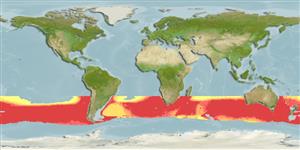>
Stomiiformes (Lightfishes and dragonfishes) >
Stomiidae (Barbeled dragonfishes) > Idiacanthinae
Etymology: Idiacanthus: Greek, idia = own privative + Greek, akantha = thorn (Ref. 45335).
Environment: milieu / climate zone / depth range / distribution range
Ecologia
marino batipelagico; distribuzione batimetrica 1239 - 2000 m (Ref. 58018). Deep-water; 25°S - 60°S
Subtropical to temperate waters in the southern hemisphere, probably limited by the subtropical convergence. Incidentally found in sub-Antarctic waters of the Southern Ocean.
Size / Peso / Age
Maturity: Lm ? range ? - ? cm
Max length : 53.0 cm SL maschio/sesso non determinato; (Ref. 7249)
Short description
Chiavi di identificazione | Morfologia | Morfometria
Spine dorsali (totale) : 0; Raggi dorsali molli (totale) : 55 - 63; Spine anali: 0; Raggi anali molli: 37 - 42. Pelvic fins with 6 rays (females), absent in males.
Mesopelagic species (Ref. 75154). Pronounced sexual dimorphism: females are black, with well developed canine teeth, barbel and pelvic fins with six stripes. Males are dark-brown, have no teeth on maxilla and neither barbel nor pelvic fins (Ref. 47377). Apparently, females live below 500 m during the day and perform vertical migration at night to shallower depths; males always in deep water, ca 1,000-2,000 m (Ref. 5169).
Life cycle and mating behavior
Maturities | Riproduzione | Spawnings | Egg(s) | Fecundities | Larve
Krueger, W.H., 1990. Idiacanthidae. p. 341-342. In J.C. Quero, J.C. Hureau, C. Karrer, A. Post and L. Saldanha (eds.) Check-list of the fishes of the eastern tropical Atlantic (CLOFETA). JNICT, Lisbon; SEI, Paris; and UNESCO, Paris. Vol. 1. (Ref. 7249)
IUCN Red List Status (Ref. 130435)
Threat to humans
Harmless
Human uses
Pesca: di nessun interesse
Strumenti
Special reports
Download XML
Fonti Internet
Estimates based on models
Preferred temperature (Ref.
123201): 2.1 - 3.7, mean 3.1 °C (based on 311 cells).
Phylogenetic diversity index (Ref.
82804): PD
50 = 0.6250 [Uniqueness, from 0.5 = low to 2.0 = high].
Bayesian length-weight: a=0.00389 (0.00180 - 0.00842), b=3.12 (2.94 - 3.30), in cm total length, based on all LWR estimates for this body shape (Ref.
93245).
Trophic level (Ref.
69278): 4.0 ±0.7 se; based on size and trophs of closest relatives
Resilienza (Ref.
120179): Basso, tempo minimo di raddoppiamento della popolazione 4.5 - 14 anni (Preliminary K or Fecundity.).
Fishing Vulnerability (Ref.
59153): Moderate to high vulnerability (46 of 100).
